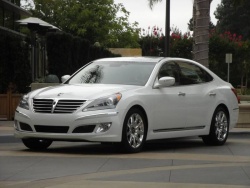 2011 Hyundai Equus. Click image to enlarge |
|
Manufacturer’s web site
|
Review and photos by Greg Wilson
Photo Gallery:
2011 Hyundai Equus
Palo Alto, California – A $70,000 Hyundai? Skeptics may snicker but it wasn’t that long ago critics were poo-pooing the $50,000 Genesis sedan, a sales success for Hyundai that was voted 2009 Canadian Car of the Year. The new Hyundai Equus full-size luxury sedan, which goes on sale in late October, will start in the mid $60,000 range with top models going for around $70,000. Firm prices have yet to be announced.
Though it will be Hyundai’s most expensive vehicle, the Equus will be cheaper than its projected competitors, the Lexus LS 460L, Mercedes-Benz S550, Audi A8, BMW 750Li, and Cadillac STS 4.6. That’s no big surprise, but with consumers’ ingrained resistance to buying a luxury car from a non-luxury nameplate – the late, great Volkswagen Phaeton is probably the best example of this phenomenon – it’s likely that Hyundai will face a steep challenge in selling them.
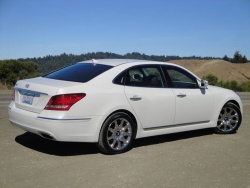 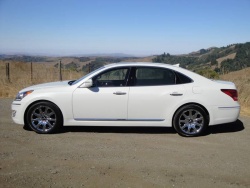 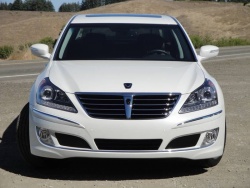 2011 Hyundai Equus. Click image to enlarge |
Curiously, Hyundai doesn’t seem to be too worried about that. “No one at Hyundai is expecting to lead the sales charts with the Equus,” said John Vernile, Vice President of Marketing at Hyundai Auto Canada. According to Vernile, the company’s goal is to sell just 80 to 100 cars in the first year. Only 27 of Hyundai’s 197 Canadian dealers, half of them in Ontario, have signed up to sell the Equus.
“Our primary goal is to redefine the perception Canadians have of Hyundai,” said Vernile.
Vernile believes there are many luxury buyers who will look beyond the nameplate. “The Equus will resonate with customers that equate luxury with the experience of owning and driving a vehicle and look beyond the badge on the hood,” he stated. Interestingly, the badge on the Equus’ hood is not a Hyundai badge, but a special Equus badge that resembles the mythological flying horse from which the car derives its name. There is, however, a Hyundai logo badge on the trunk of the Equus.
Designed, engineered and built in Korea, this second generation Equus is also sold in Korea, China and the Middle East, but not Europe. Equus models sold here are tuned and refined for North America by Hyundai’s R&D centres in California and Michigan, said Vernile. The first generation Equus was also a large luxury car, but it was a front-wheel drive model sold only in Korea.
The 2011 Equus is about the size of a Mercedes-Benz S550, and is 183 mm (7.2 in.) longer than a Genesis sedan, with which it shares it basic platform. The Equus has the same powertrain as the Genesis V8: a 4.6-litre DOHC 32-valve CVVT V8 (two-time Ward’s 10 Best Engine winner) mated to a ZF six-speed automatic transmission with ‘Shiftronic’ manual shift mode. The Equus’ engine makes 385 horsepower (10 more than the Genesis) and 333 lb-ft of torque using Premium gas and 378 horsepower and 324 lb-ft using Regular fuel.
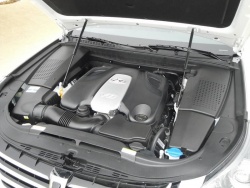 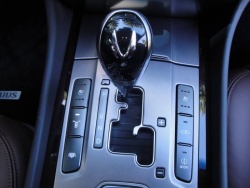 2011 Hyundai Equus. Click image to enlarge |
Using Premium fuel, the Equus V8 produces more horsepower than the engines in the Lexus LS460, Mercedes-Benz S550, and Audi A8, but less torque. Hyundai says the Equus will do zero to 100 km/h in approximately 6.4 seconds, not quite as quick as the LS 460 in 5.4 seconds and the S550 in 5.6 seconds.
Preliminary Equus fuel consumption figures of 13.4 L/100 km city/8.2 L/100 km highway are slightly better than the S550, but slightly worse than the LS 460.
The Equus features a fully independent electronically controlled air suspension that constantly monitors road conditions and driving dynamics and adjusts damping force accordingly. There is also a driver-selectable ‘Sport’ setting which firms up the pneumatic suspension and steering for a sportier driving experience. During a five-hour drive over a variety of city and country roads and highways in the Palo Alto area of California, I found the Equus’ ride extremely comfortable on smooth highways and freeways but a bit stiff over uneven and broken pavement due to what seemed to be stiff shock damping, a bit of a surprise given its automatically adjusting air suspension.
Handling is surprisingly stable with high cornering limits and minimal body lean. This improves in Sport mode, though not dramatically. Standard tires are big Continental P245/45R19-inch all-seasons in front and P275/40R19-inch tires at the rear mounted on 19-inch chrome alloy wheels.







 Follow Autos on Twitter
Follow Autos on Twitter



